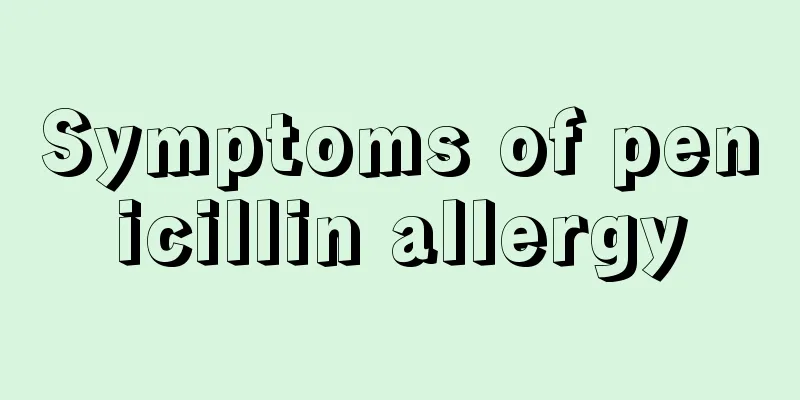Symptoms of penicillin allergy

|
Medicines are commonly used by people. They are very helpful in treating diseases. Different medicines have different effects when used. When choosing medicines, you also need to have a good understanding of them so that no abnormal phenomena will occur when using them, causing damage to your health. So what are the symptoms of penicillin allergy? Many people don’t understand this.
Many people are not very clear about the symptoms of penicillin allergy, so when choosing penicillin, they must also have a good understanding of how to use it, so that they can use it with confidence without too much threat to themselves. Symptoms of penicillin allergy: Anaphylactic shock is the most serious and common reaction to penicillin. It can occur throughout the entire process of penicillin use. It is more common in adults aged 20 to 40, more common in women than in men, less common in the elderly and children, and rare in infants. Various dosage forms and routes of administration of penicillin can cause anaphylactic shock, and the occurrence of the reaction is unrelated to the dose. Anaphylactic shock usually occurs extremely quickly, most occurring within 15 minutes after injection, even before the needle is removed. In a few cases, the symptoms may occur several hours after administration or during continuous administration. The general clinical manifestations can be divided into the following parts: 1. Symptoms of respiratory obstruction: chest tightness and shortness of breath, laryngeal obstruction, dyspnea, suffocation, cyanosis, etc., caused by laryngeal edema, bronchial spasm edema and pulmonary edema. 2. Symptoms of circulatory failure: pale complexion, chills, cold sweat, cold limbs, irritability, weak pulse, low blood pressure, etc. 3. Symptoms of the central nervous system: loss of consciousness, coma, convulsions, incontinence, etc., may be caused by brain hypoxia. Some patients may develop sequelae such as aphasia, hemiplegia, and Parkinson's syndrome. 4. Allergic skin reactions, such as itching, urticaria or other rashes. 5. Gastrointestinal symptoms: abdominal pain, diarrhea, nausea and vomiting, etc. Through the above introduction, we have a good understanding of the symptoms of penicillin allergy. When these situations occur, timely treatment must be received, which will be of great help in stabilizing the patient's disease. However, when using penicillin to treat the disease. You should also be rational in your dietary choices and reduce the choice of spicy and greasy foods. |
Recommend
What is the normal weight standard for people?
In today's society, thinness is considered be...
How to care for a lymphoma patient at home
Lymphoma is a serious disease. To save the life o...
What are the causes of hemophagocytic syndrome?
Hemophagocytic syndrome is a very harmful disease...
Liver cancer inheritance
The genetic view of liver cancer is not accurate....
What kind of care should be paid attention to after cerebral hemorrhage surgery
Nowadays, more and more people suffer from diseas...
The difference between air conditioning refrigeration and dehumidification
There is a big difference between the cooling of ...
Three factors that induce esophageal cancer
Experts say that the causes of esophageal cancer ...
Is radiotherapy or chemotherapy better for cervical cancer?
Radiotherapy and chemotherapy are two different t...
Bilirubin-removing drugs
Bilirubin is a hormone in the body that is closel...
How does Purslane remove acne?
Many friends may not know about Purslane, they ju...
What to do if your teeth are shaking
If a tooth is already loose, do not harm this par...
How to prevent Aconitum poisoning
Aconitum kusnezoffii is a common Chinese medicina...
Will vomiting definitely occur if gastric bleeding occurs?
Under normal circumstances, we will not have vomi...
What are the benefits of bluefin tuna
Bluefin tuna is indeed a relatively expensive fis...
Is vulvar leukoplakia easy to cure in the early stages?
Vulvar leukoplakia is a serious problem that plag...









